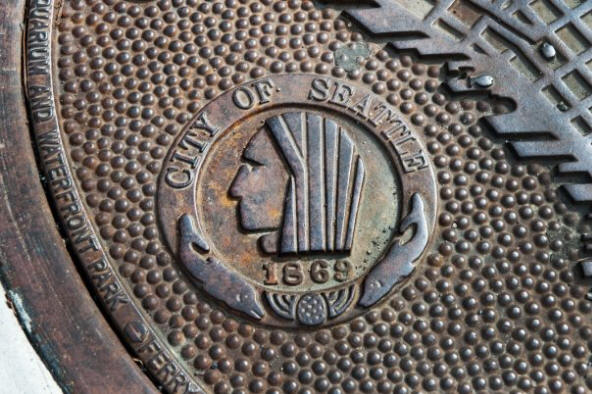

|
Seattle Odyssey is an incredulous journey that appeals .... |
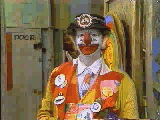 J. P. Patches b. 1928 - d. 2012 |
.... to kids of all ages
in the spirit of Alice in Wonderland. |
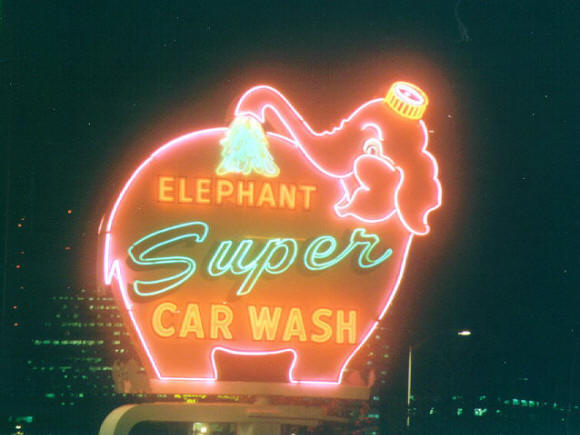 |
| The Elephant Car Wash sign rotates on Denny Way near Seattle Center. Enhanced with neon and "flowing" incandescent bulbs, the sign was constructed in 1955. |
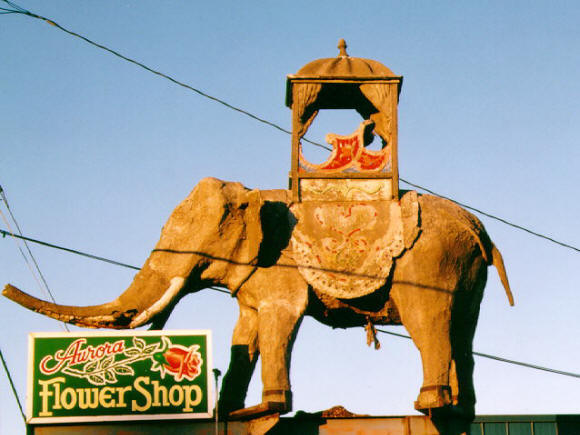 |
| The Flower Shop Elephant was built in 1926 on Aurora Ave. (just north of Green Lake) on the roof of a onetime flower shop. Why an elephant on the roof you ask? The former shop owner said: "Elephants have a great memory -- do you? Don't forget your wife's birthday!" Now you know! |
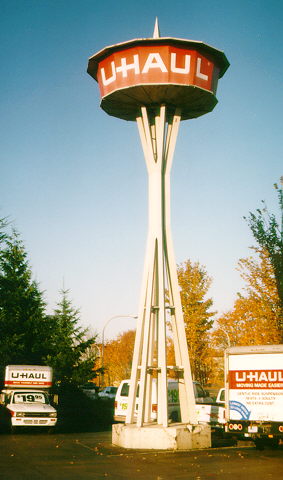 |
| Faux Needle, AKA Renton U-Haul Space Needle, is located on Rainier Ave across from Renton Airport. Sorry, no rotating restaurant but the lines aren't as long as the real deal. :-) |
 |
| You bet. Vladimir Ilyich Lenin--a 7-ton bronze statue of the bearded Bolshevik designed by noted Soviet artist Emil Vontov and erected in Poprad, Slovakia in the very twilight of the Communist era--faced a bleak future. He was torn down by angry counter-revolutionaries in 1989. An Issaquah native, Lewis Carpenter, who was teaching in Poprad, found Lenin lying face down in a puddle. Carpenter bought the statue (real cheap, rumor has it) and brought it back to Seattle. Then, in 1994, Carpenter passed away, leaving the statue to an uncertain fate. After briefly presiding over the grass-roots capitalism of Fremont's Sunday Flea Market, Lenin was taken out on his back when flooding caused serious erosion under the pavement supporting his immense weight (the weight of history, no doubt). Now Lenin has found a new home at the corner of 36th and Evanston with a new concrete pedestal firmly underfoot. It's not there to tout communism, but to serve as a reminder that art outlives politics. |
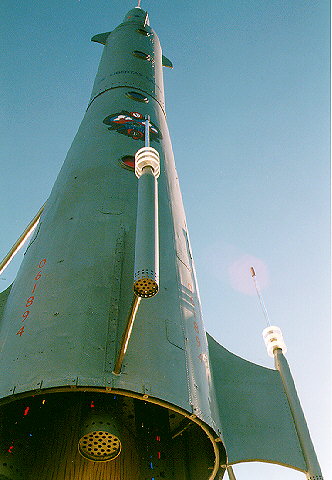 |
| The Fremont Rocket was constructed using a 1950s rocket which had graced a defunct surplus shop in Belltown. Local artists added metalwork, neon, paint and a mural of blast-off clouds and whirling galaxies. The Rocket was erected with much fanfare in 1994. Its nozzles ooze clouds of vapor at regular intervals through the day. It graces the corner of the Ah Nuts junk shop, overlooking the lot where the Fremont Almost Free Cinema screenings take place during the summer, and which hosts the Fremont Sunday Market and Flea Market. |
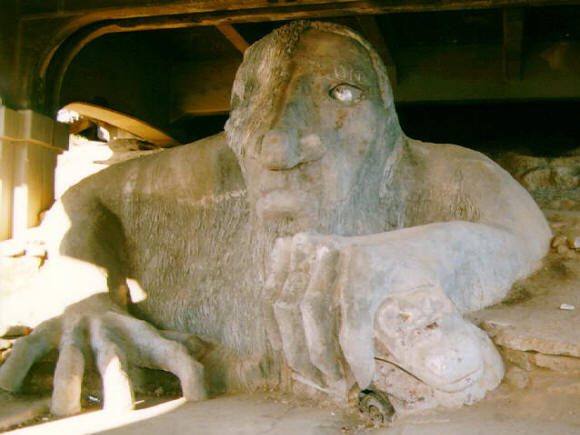 |
| The Troll is lurking under the Aurora Bridge in Fremont. And yes, that's a real Fahrvergnugen (as in Volkswagen) he - or it - is clutching- or is it crushing! Constructed in 1991, weighing 2 tons and standing 18 feet tall The Troll presides over Trolloween every Halloween. Glowing jack-o'-lanterns, hand-made luminaria, costume skits, and uninhibited drumming and dancing kick off the festivities. For this event, The Troll is bathed in eerie orange light, with a gigantic spider crawling over his shoulder and decked out with a nose-ring (actually made from the rim of a bicycle wheel). |
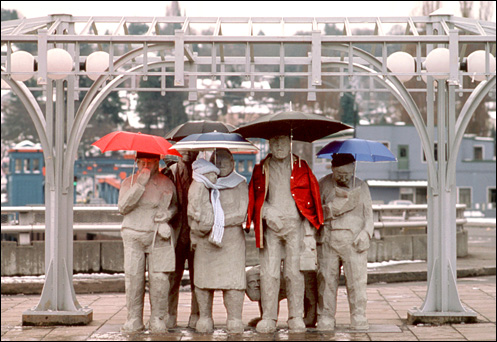 |
| Waiting for the Interurban is memorial to the trolley/rail line that once ran between Everett and Tacoma. Standing at the north end of the Fremont Bridge, these five aluminum commuters (and one dog) have waited since 1978 for a ride that never came. Decorating the statues with seasonal apparel, political signs and other props has become a Seattle tradition. Look closely and you'll notice that the dog has a human face. The sculptor modeled the face after a character once known as the "Mayor of Fremont," because of a dispute about the sculpture the two were having at the time. |
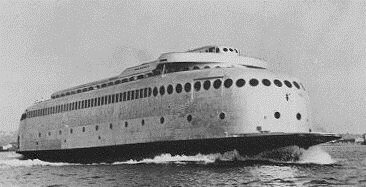 |
|
Before Seattle had the Space Needle, the "Silver Slug" was the most unique looking thing on the Sound. The m/v Kalakala (Chinook for "flying bird") was the world's first streamlined ferry boat, entering service in 1935. Like the streamlined steam trains, Pan Am China Clippers, and aerofoil automobiles of the time, she drew juice from the Art Deco style to drum up a thumping great business for the Black Ball Line in service from Seattle to Bremerton (a 30-minute ride across Puget Sound) until 1967. Then it was relegated to Kodiak Island, Alaska as a fish processing plant for 30 years. Now it is now berthed in Tacoma's Hylebos Waterway. |
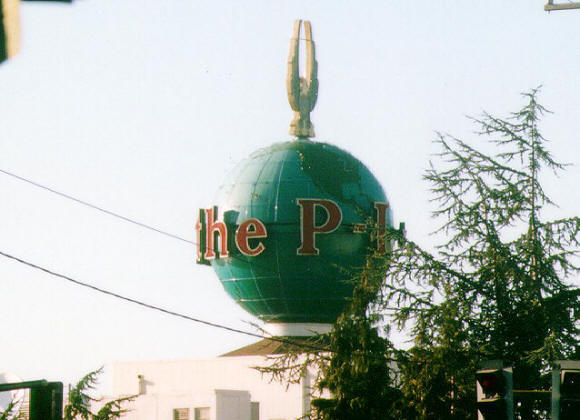 |
| Atop the Post-Intelligencer building on Elliott Bay sits a huge 18.5-ton steel, neon-lit globe bearing the slogan "It's in the P-I." The 30-foot steel globe consists of two hemispheres joined at the equator. Pacific Car and Foundry and Electrical Products Consolidated built the globe in 1948 at a cost of nearly $26,000. The slogan, "It's in the P-I," is mounted on a raceway that revolves around the globe. Capital letters are 8 feet tall; small letters are 5 feet tall. The eagle that perches atop the globe is 18.5 feet tall. |
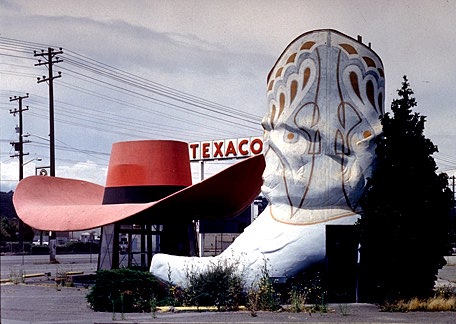 |
| The "Premium Tex", Texaco gas station, better known as the Hat n' Boots opened in 1954. Located in Seattle's Georgetown neighborhood, it was only one part of a larger shopping complex called Frontier Village. Rest rooms were in the Boots (which smelled that way), and you paid under the Hat. It is was located just north of Boeing Field and was constructed of reinforced concrete in 1953. Over time the station lost traffic to I-5 and descended from sassy to shabby and closed in 1988. However, the Georgetown community raised $250,000 to relocate Hat n' Boots to Oxbow Park and refurbished them on site in 2003. |
 |
| The Lincoln "Toe" Truck, parked in the Museum of History and Industry since 2005, used to be seen by gazillions of commuters exiting and entering I-5 (Exit 167) at the corner of Fairview and Mercer. It was constructed in 1979 with a fiberglass cast of five fat pink toes added to the cab of a miniature tow truck. At Christmas time it was seen under tow by illuminated reindeer. There are actually two Toe Trucks - the second, built in 1996, is in front of Lincoln Towing's Aurora Avenue lot, and is the one frequently seen at Seafair parades. |
 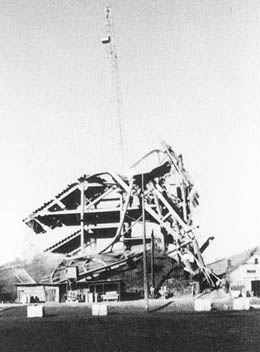  |
|
At 10:07 a.m. on Feb. 25, 1987, the dream of a 17,000-seat addition to UW's Husky Stadium suddenly came crashing to the ground in 12 seconds. A deafening bang reverberated across the campus that morning as the steel framework for a long-awaited addition crumbled upon itself, an event recorded for posterity by a part-time photographer late for work. It was truly a miracle that no one was killed, and another miracle that despite the collapse, the North Stands Addition was finished in time for the season opener against Stanford on Sept. 5. For photographer John Stamets, it started like any other day. He rode his bicycle along a campus back road that skirted Husky Stadium. Because it was a nice day, and because he always carried his camera with him, he stopped to take some construction photos. "A guy in a hard hat came walking toward me," Stamets recalls. " `You ought to take a picture of the crack. Engineers will pay you a lot of money someday for it,' he told me." Stamets did take a picture of a "crack" in the steel framework and saw that the entire structure was empty of steelworkers. Even a maintenance shed was suddenly off limits. "We're not telling KIRO about this one," the worker quipped. Suddenly Stamets' heart started beating. "You are already late for work," he told himself. "But what if it does fall down?" He crawled over and under construction trucks to get the best angle and waited. Suddenly he saw a man running hard. "I was totally psyched. I just started shooting. Then it started to go. I thought, `Oh my God, it's happening right now.' I had been standing there for only 10 minutes," he remembers. He hand cranked the film as fast as he could, capturing eight shots as the structure fell upon itself. "It turns out the last shot was the 21st frame on a roll of 20 pictures," Stamets says. While shooting the collapse, Stamets admits he was in high spirits, but as soon as it was over, his mood flipped 180 degrees. "I was sure there were dead people. I was really confused. I kept running toward the mess and then running back again." There would have been deaths--20 to 40 ironworkers were on the site in the early morning--but once workers discovered a buckle in a roof truss support beam, a construction supervisor ordered everyone off the site. Investigations later confirmed that nothing was wrong with the design of the North Stands Addition. That day, the structure suffered from inadequate lateral support. Several critical "guy wires"--cables that keep the structure from twisting--were released in error. The Lydig Construction firm worked seven days a week, sometimes in three shifts, to clean up the mess and start over. "I thought it was impossible to get the stands ready for the first game," said Bob Brison, the UW's director of engineering and construction at that time. The Husky Ticket Office even printed the season's tickets with two different seat numbers--one for Husky Stadium and one for the Kingdome, the alternate venue. As for Stamets, his photos hit the front pages of most regional newspapers. Local TV stations had a bidding war over broadcast rights. But he later realized that no one had seen the entire sequence in one package. So that fall he printed several thousand panoramic postcards with the entire sequence, including the headline "Gravity 1, UW 0." Despite the grumblings of some UW officials at the time, the postcard sold well and continues to be available at the University Book Store. "I was careful not to sell it in the `U' District until after three home games were played. And in the caption I clearly state that the collapse was not due to design errors," says Stamets. "I did not want the card to contribute to some kind of fear of the stadium." Ten years later, Stamets now works for the UW architecture department teaching photography to its students. Because it is the 10-year anniversary of the collapse, he plans to issue a framed, limited edition series of the nine photographs. While fans may chuckle over the images, Husky Stadium remains a premiere sports venue. There is some talk that someday it may get another addition. You might even find John Stamets out there with his camera when it happens.--Tom Griffin |
|
